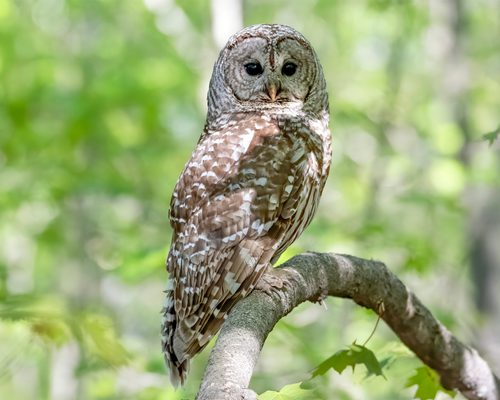When darkness falls across North American forests, the barred owl (Strix varia), also commonly known as the "hoot owl," transforms from a seemingly docile daytime rooster into one of the woodland's most versatile and effective predators.
These medium-sized owls with distinctive brown-and-white barred plumage feast on everything from tiny insects to mammals nearly their own size.
Unlike some specialist owl species, barred owls have adapted to become true dietary generalists, which has contributed to their successful expansion across diverse habitats throughout North America.
Hunting Techniques That Ensure Success
The hunting techniques of barred owls are as varied as their diet. Most commonly, they perch silently on a branch, scanning the forest floor with exceptional night vision and directional hearing before dropping silently onto unsuspecting prey. Their specialized feathers muffle sound so effectively that a mouse might never hear the approach until talons are already closing around it.
Barred owls are most active at dawn and dusk (crepuscular), though they certainly hunt throughout the night and occasionally during daylight hours, especially when feeding young.
Some barred owls have even been observed wading into shallow water to stalk fish and crayfish, demonstrating their remarkable adaptability as hunters.

Barred Owl eating a vole during the winter
Evidence of a Diverse Diet
Examining the ground beneath a barred owl's favorite perch often reveals the evidence of their diverse diet. Regurgitated pellets—compact masses of indigestible bones, fur, and exoskeletons—tell the story of recent meals. A single pellet might contain the remains of a vole, fragments of crayfish exoskeleton, and beetle wings, demonstrating their opportunistic feeding strategy.
Larger prey, such as rabbits or squirrels, are typically dismembered before consumption, with the owl using its sharp beak to tear manageable pieces rather than swallowing them whole as many people believe. Squirrels are actually one of the barred owl's main food sources in many woodland habitats, along with other small mammals like voles and mice.

Hoot Owl perched in a tree, eating a crayfish
Seasonal Dining Habits
The barred owl's menu changes significantly with the seasons. Spring brings an abundance of nestling birds and young mammals, providing easily captured protein when adult owls are often feeding hungry owlets of their own.
Summer sees increased hunting of frogs, snakes, and other reptiles as these cold-blooded creatures become more active. Barred owls have particular preferences for certain snake species, including rat snakes, ribbon snakes, and common garter snakes.
When winter blankets the landscape, barred owls rely more heavily on rodents, which remain active beneath the snow where the owl's exceptional hearing can still detect their movements. This dietary flexibility allows barred owls to thrive year-round in territories where more specialized predators might struggle during certain seasons.

Barred Owl in flight, looking for prey
Feeding the Next Generation
Baby barred owls, called owlets, rely entirely on their parents for food during their first months of life. Parents typically start their young on smaller, easier-to-digest prey like insects and small mice.
Unlike most other owl species, barred owl young remain with their parents for approximately four months—an unusually long period of parental care.
As the owlets grow, parents gradually introduce larger prey items, teaching them through example what will eventually form their adult diet.

Barred Owl feeding owlet
Barred Owls and Humans
Barred owls are relatively tolerant of human presence compared to other owl species, which sometimes brings them into closer contact with our habitats and pets. While extremely rare, there have been documented cases of barred owls attacking domestic cats, particularly small ones. Small dogs and puppies could potentially be at risk, though documented cases are exceedingly rare.
For those hoping to observe barred owls, creating an environment that attracts their natural prey is more beneficial than leaving food directly for the owls. Allowing areas of grass to grow longer can attract rodents, which in turn may attract hunting barred owls. Offering food directly to owls can create harmful dependencies and is generally discouraged by wildlife experts.

Barred Owl eating prey high up on a branch

